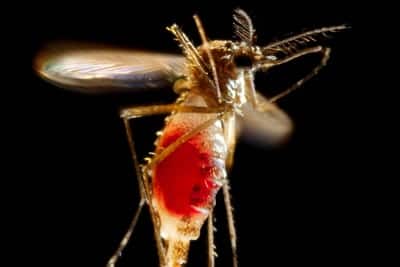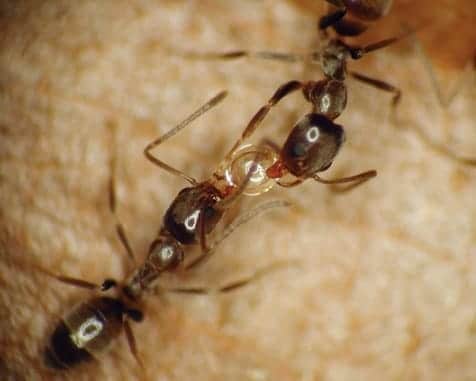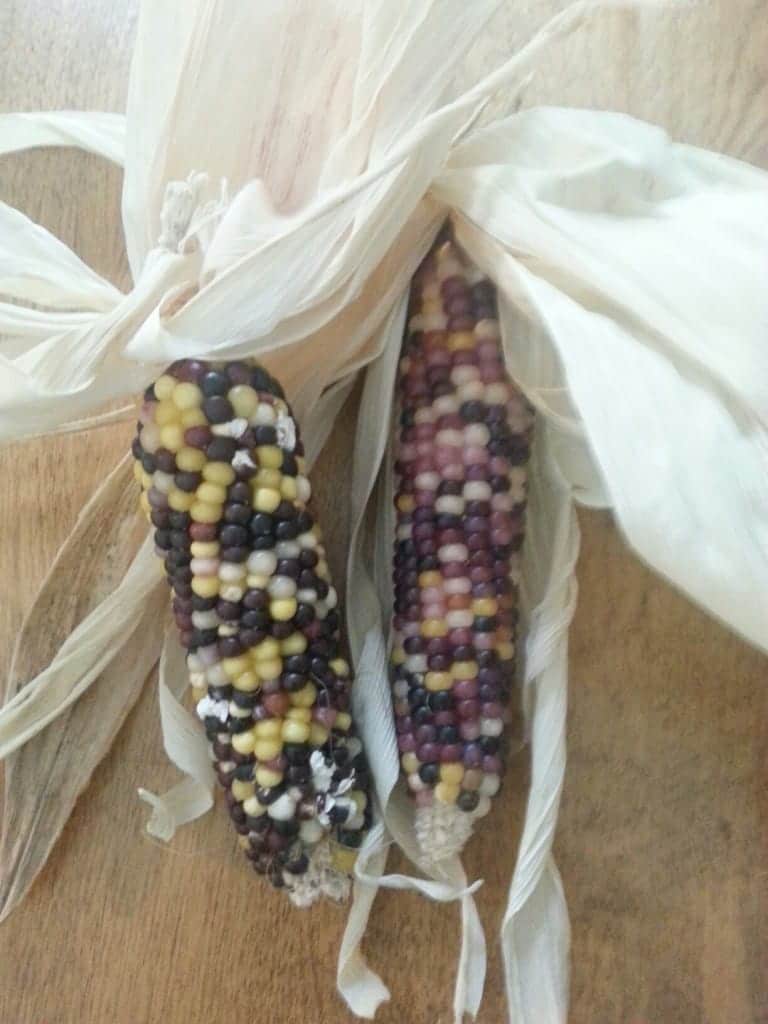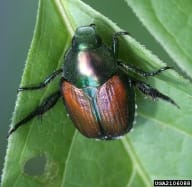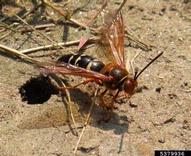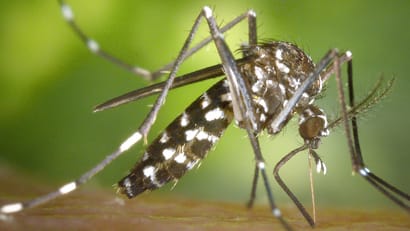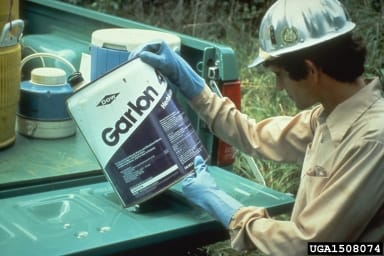Seven months after the mosquito-borne virus chikungunya was recognized in the Western Hemisphere, the first locally acquired case of the disease has surfaced in the continental United States. The case was reported today in Florida in a male who had not recently traveled outside the United States. The Centers for Disease Control and Prevention is working closely with the Florida Department of Health to investigate how the patient contracted the virus; CDC will also monitor for additional locally acquired U.S. cases in the coming weeks and months.
Month: July 2014
Can we use the behavior of these ants to better control them?
Information on using bait formulations for insect control. Taken from the publication Insecticide Basics for the Pest Management Professional
Daniel R. Suiter, UGA Department of Entomology & Michael E. Scharf, UFL Department of Entomology and Nematology
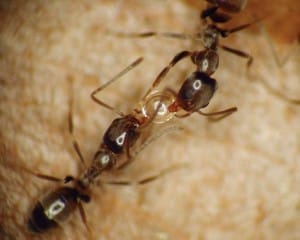
See the rest of the publication at Insecticide Basics for the Pest Management Professional
Bait Formulations. Baits must be eaten by the target pest — typically rodents, termites, ants, cockroaches, and other miscellaneous pests (Figure 2). Baits are comprised of an active
ingredient incorporated into a palatable, if not preferred, food source. Bait products usually contain inert ingredients (e.g., preservatives, thickeners, gels, and fillers) intended to stabilize and enhance the shelf life and palatability of the bait. Logically, it is important that bait ingredients (actives and inerts) not be a deterrent to feeding.
Baits are most commonly formulated as ready-to-use liquids, gels, pastes, granules, dusts,
stations, pellets, and blocks. Depending on the product’s label, baits can be used both indoors
and outdoors, are generally target-specific, and are considered environmentally-friendly
because only small amounts of active ingredient are delivered, usually from a point source.
Because baits must be eaten, it is important to keep them away from non-target organisms.
To facilitate bait consumption:
- Neither the active ingredient nor any other part of the bait should be a feeding deterrent.
- The food source should be palatable (perhaps even preferred) by the target pest.
In addition, for social insect pests (especially ants) it is important that the active ingredient be slow acting. Ants and termites share food with their colony mates in a social behavior known as trophallaxis (Figure 1). Trophallaxis results in active ingredient distribution throughout social insect colonies. It is, therefore, important that the active ingredient be slow acting over a range of concentrations in order to provide sufficient time for toxicant distribution among nestmates. Fast-acting active ingredients or excessively high concentrations of the active ingredient may too quickly impair a social insect’s ability to engage in trophallaxis, thereby rendering the bait less effective.
See the rest of this publication at Insecticide Basics for the Pest Management Professional
Growing Popcorn
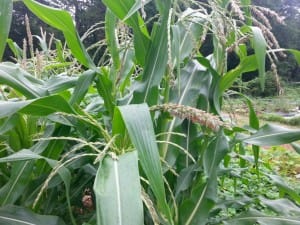
Sweet corn can be a challenge to grow in the community garden, especially for the one to two ears you get for each corn stalk. It can shade your other crops, or your neighbor’s. Some community gardens have rules that prohibit growing corn for that reason. Popcorn can be another story. The cultivars can be shorter than sweet corn and even though the yield is about the same, you can make popcorn last a long time.
Tom Thumb popcorn grows to be about 3 feet tall and is a popular cultivar all over the country. Pennsylvania Butter Flavor, Dakota Black, and Cherokee Long Ear are cultivars Master Gardeners have had great success growing in Georgia. Know that all corn types, including popcorn, are heavy feeders so make sure you have good fertility in the soil. If you can plant the corn where a legume has been growing – fantastic! The legume will have added nitrogen to the soil for you! You will want to add some compost or nitrogen when the corn is about 6 inches high and again when it is about knee high.
Sow twice as many seeds as you think you will need and thin to about 8-12 inches apart. Keep weeds at bay and when the corn is about knee high add soil over the exposed roots for good support. If you decide to try growing popcorn this late in the season, determine how many days until maturity (usually this information is on the seed package) and make sure it will have time to mature before frost.
The trick to successfully growing popcorn is to know it is wind pollinated. The pollen of the male flowers (the tassels) need to
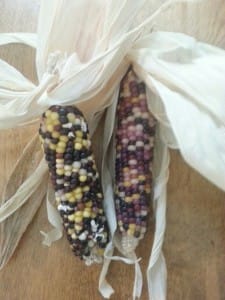
reach the female flowers (the silks). Especially when you are growing limited amounts you want to think “blocks” instead of “rows”. Planting in squares will drastically improve pollination as the wind-blown pollen grains will have a better chance at landing on another corn stalk. So for a 4′ X 8′ plot you could have four stalks across and at least four stalks down the plot for a total of at least 16 stalks. With this plot size, know popcorn would take up at least half of your plot area. This would probably be a minimum for good pollination. You could always help the wind out by gently shaking the stalks yourself!
The wind pollination can be an issue if another community gardener is also growing another type of corn, especially if either one of you is planning on saving seed. You could get cross- pollination. You may want to separate your planting dates by a couple of weeks so that the corn doesn’t tassel at the same time. Or maybe you all can grow the same type of popcorn.Your local Extension Agent has all types of information on growing all types of corn.
Let the popcorn ears remain on the stalks until the husks are dry. The downside here is this takes time that could be used to start another crop. Bring it inside to finish drying for several weeks. You can remove the corn kernels from the ears by hand, by twisting the kernels off or by rubbing two cobs together. Experience teaches that it is fairly easy to remove them by flicking them off with your thumb. This winter when there is a nice fire in the fireplace and a good book in hand, you will appreciate the time and effort it took to grow your own popcorn!
Happy Gardening!
UGA Webinar Series Now Offers 2 Hours of Credit!
Dan Suiter, UGA Department of Entomology
The Urban & Structural IPM program at the University of Georgia started a webinar series this year for pest management professionals. Go to www.gabugs.uga.edu to learn more, including upcoming dates, speakers, and topics. Our series now provides CCU/CEU credit in GA, AL, FL, NC, SC, and TN.
We are announcing the doubling of credit for our series, from 1 to 2 hours. Webinars from this point forward will begin at 8:00 AM and finish at 10:00 AM, while providing 2 CEUs for attendees.
Our next webinar is August 20, 2014 from 8:00 to 10:00 AM. Dr. Brian Forschler will discuss the Biology and Management of Subterranean Termites, and Dr. Dan Suiter will talk about Demystifying Wood-eating Beetles. GA operators will receive 2 hours of WDO credit.
Should you have a question about this or any other upcoming webinar, don’t hesitate to contact me at 770-233-6114 or dsuiter@uga.edu. Alternatively, visit our website at www.gabugs.uga.edu.
Recognize this large wasp found in landscapes now?
Cicada Killer Wasps
Nancy Hinkle, UGA Extension Entomologist
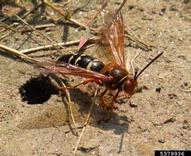
The cicada killer wasp is the largest wasp in Georgia. The cicada killer wasp is almost two inches long. Although intimidating in appearance, these wasps are not something we humans have to worry about. Cicadas, on the other hand, should be very afraid. Cicada killer wasp adults feed on nectar but use paralyzed cicadas to feed their young.
Female cicada killers are hard to provoke to sting. The female uses her stinger to paralyze her prey (cicadas) rather than in self defense. The female’s attention is focused on providing food for her babies, so she poses little threat to humans.
Cicada killers prefer to nest in sandy open sunlit areas. As the female digs, she kicks out soil that forms a semicircle around the burrow opening. She burrows six to ten inches into the ground, prepares a chamber, catches a cicada to fill the chamber, lays an egg on the cicada, and seals the chamber. She may do this over a dozen times in one burrow.
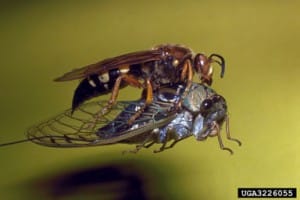
When a female finds a cicada, she paralyzes it with her stinger, straddles it, and attempts to fly with it to her burrow. Because the cicada typically weighs more than she does, these flights are usually hops, with more dragging than gliding.
The egg hatches in a few days and the larva feeds on the paralyzed cicada until nothing is left but a shell. Then the wasp larva pupates within the burrow, remaining there until the next spring.
Males cannot sting; their only defense is intimidation. They patrol the nesting area, trying to divert attention away from the female, allowing her to provision her nest with cicadas. Meanwhile the male is using threatening tactics to distract potential predators. He may even dive bomb perceived threats. Since the males do not have stingers, they are completely harmless. They must rely on bluff, bluster, and bravado to protect their families.
Because cicada egg laying can be damaging to trees and shrubs, cicada killer wasps are very beneficial, providing free biological control. However, homeowners who do not want these wasps around can modify their lawn to be unappealing. A thick healthy turf with no bare spots will exclude cicada killer wasps. If turf is thin in nesting areas, identify turf problems that make the turf weak and correct them.
Cicada killer wasps will be active for only a few weeks and will be gone by mid-August in most of Georgia. If someone is bothered by these wasps, late July and early August would be a good time to take their vacation.
For more on cicada killer wasps, see these articles:
Japanese beetles return to Georgia landscapes
Paul Pugliese, Agriculture & natural resources agent for the University of Georgia Cooperative Extension office in Bartow County
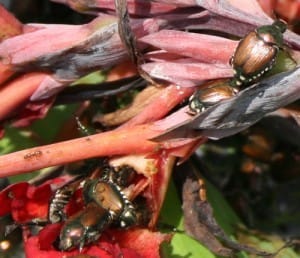
With their metallic copper and blue-green bodies and bronze wings, Japanese beetles might be considered beautiful if not for the damage they cause. The plentiful beetles munch holes into the leaves of landscape plants leaving what is often described as skeletal remains.
Prior to last year, Georgia had a few years of drought and unusually mild winters. The warm, dry soil conditions were not conducive for Japanese beetle grubs to survive over the fall and winter throughout most of Georgia. This gave Georgia gardeners and landscapes a nice reprieve from the pest and its damage.
Perfect conditions return
This past winter was ideal for Japanese beetle grubs and home and commercial gardeners are suffering through a resurgence of adult beetles this summer. The severity of local Japanese beetle populations varies depending on temperature and soil moisture. Most surveys indicate that Japanese beetles do not occur further south than the “fall line” between Macon and Augusta in Georgia. Yet, they can be found as far north as Canada.
If you’ve fought Japanese Beetles before, there’s a good chance they will return to your landscape – especially if your have some of their preferred plants. Japanese beetles feed on more than 300 species of broad-leaved plants but prefer about 50 species. Commonly attacked hosts include peach, cultivated and wild grapes, raspberry, plum, roses, apple, cherry, corn, hibiscus, hollyhock, dahlia, zinnia, elm, horse chestnut, linden, willow, crape myrtle, elder, evening primrose and sassafras.
They love leaves
The good news is the beetles only affect the leaves of trees and shrubs, so healthy plants can tolerate significant leaf loss without long-term consequences.
Adult Japanese beetles live four to six weeks, lay eggs (mostly in mid-August) and die. If the soil is sufficiently moist, the eggs will swell and produce larvae in about two weeks. The rest of the year, the beetles live underground in a larval stage feeding on the roots of grass and other plants before maturing into adult beetles in the summer.
Japanese beetle larvae are plump, C-shaped white grubs often seen in the spring when garden soil is first tilled. The grubs need soil moisture to survive the winter. Frequently irrigated lawns and landscapes tend to have higher grub populations.
Adult beetles emerge from the soil and begin seeking out plants for food in late May and early June. The first round of beetles are known as “scouts” because they find a good food source and release pheromone scents to attract more beetles. The masses then gather to feed and mate.
Control the first ones!
The key is to catch the early arrivers as soon as possible. Handpick or knock adult beetles off plants and drown them in soapy water. This is an effective control option for managing small infestations and preventing them from attracting more beetles.
Pheromone lure traps are not recommended for general Japanese beetle control in a small garden. They tend to attract more beetles to the area than would normally be present. Trapping should be done in areas away from gardens or landscapes to lure beetles away from desired plants.
Adult beetles can be controlled with over-the-counter insecticides. During heavy beetle outbreaks, sprays may be needed every seven to ten days to protect high-value, specimen plants like roses. A single application of a longer-lasting systemic insecticide, like imidacloprid, needs to be made 20 days before adult Japanese beetles are expected — usually around mid-May. Most systemic treatment options are not labeled for use on plants that produce edible fruits. Read and follow pesticide label’s application rates and safety precautions.
Controlling the grub stage generally has little effect on the overall damage caused by adult beetles, since adults can fly into your landscape from up to a mile away. Most homeowners rarely have grub populations large enough to cause damage to home lawns. Treatment may be necessary if more than five to ten grubs per square foot are present in lawns. Late summer and early fall insecticide applications are most effective at killing young grubs.
Do you recognize this large wasp found in landscapes now?
Cicada Killer Wasps
Nancy Hinkle, UGA Extension Entomologist

The cicada killer wasp is the largest wasp in Georgia. The cicada killer wasp is almost two inches long. Although intimidating in appearance, these wasps are not something we humans have to worry about. Cicadas, on the other hand, should be very afraid. Cicada killer wasp adults feed on nectar but use paralyzed cicadas to feed their young.
Female cicada killers are hard to provoke to sting. The female uses her stinger to paralyze her prey (cicadas) rather than in self defense. The female’s attention is focused on providing food for her babies, so she poses little threat to humans.
Cicada killers prefer to nest in sandy open sunlit areas. As the female digs, she kicks out soil that forms a semicircle around the burrow opening. She burrows six to ten inches into the ground, prepares a chamber, catches a cicada to fill the chamber, lays an egg on the cicada, and seals the chamber. She may do this over a dozen times in one burrow.
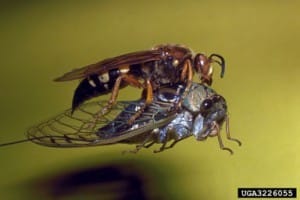
When a female finds a cicada, she paralyzes it with her stinger, straddles it, and attempts to fly with it to her burrow. Because the cicada typically weighs more than she does, these flights are usually hops, with more dragging than gliding.
The egg hatches in a few days and the larva feeds on the paralyzed cicada until nothing is left but a shell. Then the wasp larva pupates within the burrow, remaining there until the next spring.
Males cannot sting; their only defense is intimidation. They patrol the nesting area, trying to divert attention away from the female, allowing her to provision her nest with cicadas. Meanwhile the male is using threatening tactics to distract potential predators. He may even dive bomb perceived threats. Since the males do not have stingers, they are completely harmless. They must rely on bluff, bluster, and bravado to protect their families.
Because cicada egg laying can be damaging to trees and shrubs, cicada killer wasps are very beneficial, providing free biological control. However, homeowners who do not want these wasps around can modify their lawn to be unappealing. A thick healthy turf with no bare spots will exclude cicada killer wasps. If turf is thin in nesting areas, identify turf problems that make the turf weak and correct them.
Cicada killer wasps will be active for only a few weeks and will be gone by mid-August in most of Georgia. If someone is bothered by these wasps, late July and early August would be a good time to take their vacation.
For more on cicada killer wasps, see these articles:
Chikungunya Virus is Expected to Become Established in the U.S.
Reprinted from Entomology Today – Read the entire article here.
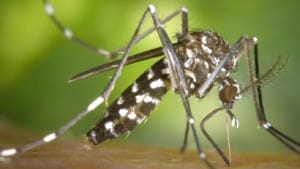 About six months ago, the U.S. Centers for Disease Control issued a travel warning for people visiting islands in the Caribbean because chikungunya virus had been detected on the island of St. Martin. This was the first time it had been detected in the Americas.
About six months ago, the U.S. Centers for Disease Control issued a travel warning for people visiting islands in the Caribbean because chikungunya virus had been detected on the island of St. Martin. This was the first time it had been detected in the Americas.
Now, in addition to the islands, health authorities are preparing for the virus to infect people in the U.S. itself.
“It’s not a matter of if, but when,” Dr. James Crowe, an infectious disease expert at Vanderbilt University, recently said to USA Today.
According to the National Association of County and City Health Officials (NACCHO), “it is virtually certain” that the virus will become established in the U.S. According to Paul Etkind, senior director for infectious diseases at NACCHO, “Local health departments should expect to see more of these cases as travel to the Caribbean for business and pleasure purposes increases over time. In addition, hundreds of thousands of soccer fans, many from the United States, are expected to travel to Brazil in July for the World Cup. The opportunities for introduction of the virus via infected fans returning from the games will be many.”
Prevent White Grubs Now
Will Hudson, UGA Extension Entomologist
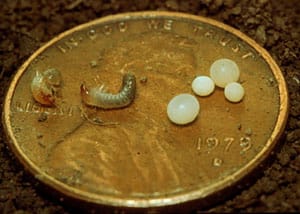
June and July are excellent times to prevent white grubs in turf. White grubs live in the soil and feed on the roots of turf. Most white grubs have a one year life cycle in Georgia. Adult beetles lay eggs in late spring or early summer. The eggs hatch into grubs which feed and grow through the summer and fall, then dig down to spend the winter deep in the soil. They become active as the soil warms in the spring, and feed for a few days to a few weeks, depending on the species. They then turn into pupae before emerging as adult beetles to continue the cycle.
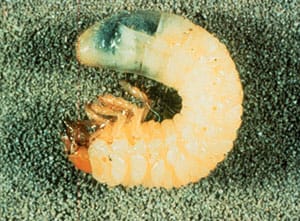
White grubs are the immature stage of Scarab beetles like green June beetles, Japanese beetles, chafers and others. The scarabs are a large family of beetles, and there are perhaps two dozen different species of white grub that might be found feeding on the roots of turf in Georgia. Included in this group are some of the most serious insect pests a turf manager will face.
White grubs damage turf by feeding on the roots during the summer and fall and, to a lesser extent, in the spring before pupation. Very dry conditions can reduce survival of both eggs and small grubs.
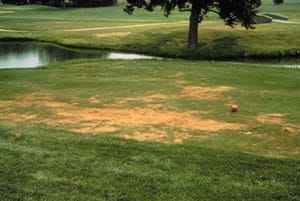
Symptoms of white grub damage are similar to other factors that damage the root system – disease, soil compaction, poor fertility, or drought. Except for the green June beetle, grubs never come to the surface until they become adults. The only way to tell if a lawn is infested is to dig the grubs up.
To scout for white grubs, cut 3 sides of a square of turf and lay the grass back like a carpet. Dig gently in the soil to a depth of 4 inches and count the grubs you see. It is important to identify the grubs before you treat. The potential for turf damage is dependent on the number and types of white grubs present. Your county agent can help identify grubs or see the publication White Grub Pests of Turfgrass on the CAES Entomology Department website.
It is easiest to find white grubs in early spring and late summer (late August) when they are larger and easy to see. That is not the best time to treat, however. Treatments are more effective if applied while grubs are small. In most of Georgia, this means application in June or July for best control. Once white grubs get bigger, there are fewer effective options and higher pesticide rates will be required. Good soil moisture and watering in the pesticide is also important for white grub control.
See White Grubs of Turfgrass for good information on control measures. Consult the Georgia Pest Management Handbook for current pesticide recommendations. Follow all label recommendations when using any pesticide.
UGA publication provides basic insecticide info for pest management professionals
Pesticide Definitions taken from
Insecticide Basics for the Pest Management Professional
Dr. Daniel R. Suiter, University of Georgia Department of Entomology and
Dr. Michael E. Scharf, University of Florida Department of Entomology and Nematology
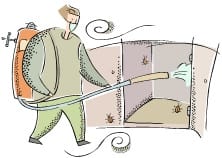 The U.S. Environmental Protection Agency (EPA) defines a pesticide as “any substance or mixture of substances intended for preventing, destroying, repelling, or mitigating any pest.” For the purpose of this bulletin, we subscribe to a more stringent definition of a pesticide as “any chemical or mixture of chemicals intended to destroy any pest.”
The U.S. Environmental Protection Agency (EPA) defines a pesticide as “any substance or mixture of substances intended for preventing, destroying, repelling, or mitigating any pest.” For the purpose of this bulletin, we subscribe to a more stringent definition of a pesticide as “any chemical or mixture of chemicals intended to destroy any pest.”
Active ingredient. The chemical substance(s) responsible for achieving a product’s desired effect.
Technical grade active ingredient. The chemical substance(s) (pesticide) in its pure, raw form (usually 95% to 100% active ingredient) prior to being formulated into a product.
Inert ingredient. Inert ingredients are biologically inactive (i.e., they typically have no pesticidal properties) chemicals that are mixed with active ingredients in order to produce an end-use, for-sale product. Some commonly used types of inert ingredients and their function include:
- Emulsifiers. Allow petroleum-soluble (but water insoluble) active ingredients to evenly disperse in water.
- Diluents and Carriers. Are meant to dilute the amount of active ingredient in a formulation and to carry it to its intended target. Often the same material serves as both diluent and carrier. For example, talc is an inert ingredient in many dust formulations. Only a small part of the dust formulation is insecticidal. The remainder is inert talc that not only dilutes the active ingredient but also serves to carry it to its intended target. In liquid spray formulations, water is both a diluent and carrier. In granular formulations, the inert granule on which the pesticide is absorbed is the carrier.
- Stickers. Allow active ingredients to stick or adhere to the treated surface.
- Wetting agents (e.g., spreaders, dispersants, penetrants). An inert chemical that is added to water to increase spreading and/or penetration by eliminating or reducing surface tension. For example, a drop of water will “bead” on wax paper, but when a spreader/dispersant is added the water droplet spreads evenly over the wax paper. Wetting agents are used in wettable powder formulations to allow the powder to evenly mix with water.
Solution. A liquid and all the chemicals that are dissolved in the liquid. For example, sugar or salt dissolve completely when placed in water to make a “sugar solution” or “salt solution”. In this example, water is called the solvent and the sugar/salt called the solute. When a chemical is soluble in a liquid, it forms a solution and cannot separate.Suspension. A liquid that contains solid particles that are not dissolved. Over time, the solid particles will settle to the bottom of the container. Many liquid spray formulations (wettable powders, suspendable concentrates, and microencapsulates) are suspensions in water, and will settle to the bottom of the sprayer if not agitated. Suspensions should be shaken, or agitated, often to resuspend the product in the water.
Contact toxicants are chemicals that penetrate the target organism on contact. For example, liquid sprays are usually effective only after an insect crawls on the treated surface and contacts the residual deposit.
Oral toxicants are chemicals that act after having been ingested by the target organism. For example, bait products kill only after an insect consumes the bait containing the active ingredient.
Fumigants are chemical gasses. They act after an insect breathes them.
See the entire publication here!
